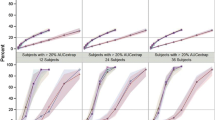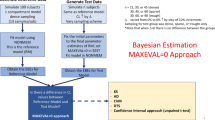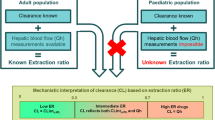Abstract
Monte Carlo simulation technique used to evaluate the effect of the arrangement of concentrations on the efficiency of estimation of population pharmacokinetic parameters in the preclinical setting is described. Although the simulations were restricted to the one compartment model with intravenous bolus input, they provide the basis of discussing some structural aspects involved in designing a destructive (“quantic”) preclinical population pharmacokinetic study with a fixed sample size as is usually the case in such studies. The efficiency of parameter estimation obtained with sampling strategies based on the three and four time point designs were evaluated in terms of the percent prediction error, design number, individual and joint confidence intervals coverage for parameter estimates approaches, and correlation analysis. The data sets contained random terms for both inter- and residual intra-animal variability. The results showed that the typical population parameter estimates for clearance and volume were efficiently (accurately and precisely) estimated for both designs, while interanimal variability (the only random effect parameter that could be estimated) was inefficiently (inaccurately and imprecisely) estimated with most sampling schedules of the two designs. The exact location of the third and fourth time point for the three and four time point designs, respectively, was not critical to the efficiency of overall estimation of all population parameters of the model. However, some individual population pharmacokinetic parameters were sensitive to the location of these times.
Similar content being viewed by others
REFERENCES
G. Zbinden. Metabolic studies in chemical safety evaluation. In J. Caldwell and G. D. Paulson (eds.) Foreign Compound Metabolism. Taylor & Francis, London, 1984, pp 203–211.
D. Z. D'Argenio. Optimal sampling times for pharmacokinetic experiments. J. Pharmacokin. Biopharm. 6: 41–53 (1981).
J. J. Di Stefano III. Optimized blood sampling protocols and sequential design of kinetic experiments. Am. J. Physiol. 240: R259–R256 (1981).
D. Smith, M. J. Humphrey, and C. Charuel. Design of toxicokinetic studies. Xenobiotica 20: 1187–1199 (1990).
E. M. Landaw. Optimal design for individual parameter estimation in pharmacokinetics. In M. Rowland, L. W. Sheiner, J. L. Steimer (eds.), Variability in Drug Therapy: Description, Estimation and Control. Raven Press, New York, 1985, pp 187–200.
L. Endrenyi. Design of experiments for estimating enzyme and pharmacokinetic experiments. In L. Endrenyi (ed.), Kinetic Data Analysis of Enzyme and Pharmacokinetic Experiments. Plenum Press, New York, 1981, pp 137–167.
L. Endrenyi and B. H. Dingle. Optimal design of experiments for the precise estimation of single—exponential kinetic model parameters. In G. Bozler and J. M. Van Rossum. Pharmacokinetics During Drug Development—Data Analysis and Evaluation Techniques. Gustav Fischer Verlag, Stuttgart, 1982, pp 149–173.
B. Mannervik. Design and analysis of kinetic experiments for discrimination between rival models. In L. Endrenyi (ed.), Kinetic Data Analysis of Enzyme and Pharmacokinetic Experiments. Plenum Press, New York, 1981, pp 235–270.
M. K. Al-Banna, A. W. Kelman, B. Whiting. Experimental Design and efficient parameter estimation in population pharmacokinetics. J. Pharmacokin. Biopharm. 18: 347–60 (1990).
Y. Bard. Nonlinear Parameter Estimation. Academic Press, New York, 1974, pp 46–47.
J. P. McGovern, M. G. Williams, and J. C. Stewart. Inter species comparison of avicin pharmacokinetics. Drug Metab. Disp. 16: 18–22 (1988).
S. L. Beal, L. B. Sheiner. NONMEM Users Guide, Parts I–IV, Division of Clinical Pharmacology, University of California, San Francisco, 1979–1992.
L. B. Sheiner LB and S. L. Beal. Evaluation of methods of estimating population pharmacokinetic parameters. III. Monoexponential model: Routine clinical pharmacokinetic data. J. Pharmacokin. Biopharm. 11: 303–319 (1983).
E. I. Ette, A. W. Kelman., C. A. Howie, and B. Whiting. Interpretation of simulation studies for efficient estimation of population pharmacokinetic parameters. Ann. Pharmacother. 27: 1034–1039 (1993) and Correction, Ann. Pharmacother. 27: 1548.
E. I. Ette. Efficient Parameter Estimation in Preclinical Animal Pharmacokinetic Studies. Ph.D thesis. University of Glasgow, Scotland, 1991.
L. B. Sheiner and S. L. Beal. A note on confidence intervals with extended least squares parameter estimates. J. Pharmacokin. Biopharm. 15: 93–100 (1987).
B. Whiting. The population approach: applications to date. An overview. In M. Rowland and L. Aarons (eds.), New Strategies for Drug Development and Clinical Evaluation: the Population Approach, Commission of the European Communities, European Cooperation in the field of Scientific and Technical Research, Brussels, 1992.
Author information
Authors and Affiliations
Rights and permissions
About this article
Cite this article
Ette, E.I., Howie, C.A., Kelman, A.W. et al. Experimental Design and Efficient Parameter Estimation in Preclinical Pharmacokinetic Studies. Pharm Res 12, 729–737 (1995). https://doi.org/10.1023/A:1016267811074
Issue Date:
DOI: https://doi.org/10.1023/A:1016267811074




